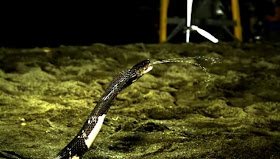As the name implies, spitting cobras spit venom at things that threaten them. This particular venom is pretty specific. If you just get a little on your (uninjured) skin, there’s not much of a problem. But if you get it in your eyes, expect immediate pain.
Cobras aim for the eyes.

The cobra has some physics to contend with to hit their target, for two reasons. First, think about how much you have to move your wrist to move the beam of a flashlight between two points. As you move the item farther and farther back, the amount of angle you have to move your wrist to flick the light back and forth between those two targets gets smaller and smaller.
Second, think about the spraying something, whether it be spritzing your flowers or sending water through the garden hose. As the liquid emerges, it’s in a fairly tight, cohesive stream. But as that stream travels away from the source, it’s going to start to break up and spread out.
The authors here suspected that the cobras were take advantage of the physics of the situation. Previous work had shown that spitting cobras make fast head movements when spitting. These were hypothesized to help ensure that the cobra hit one of the eyes. But given the widening of the stream that will happen just by the physics, the authors predicted that the cobra should make smaller head movements as their target got further away.
The test was simple – if you can ever call an experiment that involves pissing off a deadly venomous snake “simple.” They placed the cobras in an arena, had an experimental wearing a visor with a plastic screen on it walk towards the snake and until the cobra to spit venom. Film it all, measure the distances, and see where the venom lands.
The tricky bit is actually taking the complex splatter of spray and turning it into something that you can measure. It’s a little like trying to give a number to Jackson Pollack paintings. But the authors found something pretty simple. They used the the venom drops 1 mm in size or bigger to define the edges of a rectangle.
The bottom line is fairly simple: the further away the target, the smaller the angle that the cobra sprayed its venom.
Venomous snakes don’t necessarily take unloading their venom lightly. It takes time to make venom. An animal wants to make every one of those uses count.
Reference
Berthé, R., Pury, S., Bleckmann, H., & Westhoff, G. (2009). Spitting cobras adjust their venom distribution to target distance Journal of Comparative Physiology A DOI: 10.1007/s00359-009-0451-6
Additional: New Scientist covers this article.

Second, think about the spraying something, whether it be spritzing your flowers or sending water through the garden hose. As the liquid emerges, it’s in a fairly tight, cohesive stream. But as that stream travels away from the source, it’s going to start to break up and spread out.While this is true, I'm not sure it makes a significant contribution to the total spread of the venom spray, over the distances we're talking about. (The snakes were spitting at a distance of only one or two feet, for the most part.)
ReplyDeleteIn any case, the authors appear to have ignored this factor, and for that matter, so did the snakes. The paper's "optimal angle" calculations are based purely on the first factor you mention (panning across a more distant target requires a smaller angle). And the snakes actually covered a little more angle than this optimal amount--whereas, if they were exploiting the breakup of the venom stream, you'd think they could get away with covering a little less.
Good point.
ReplyDeleteOne thing to note is that these distances less than a meter – are fairly short for spitting cobras, when can spit up to 3 meters. That “spray” factor of the venom might become affect behaviour at longer distances.